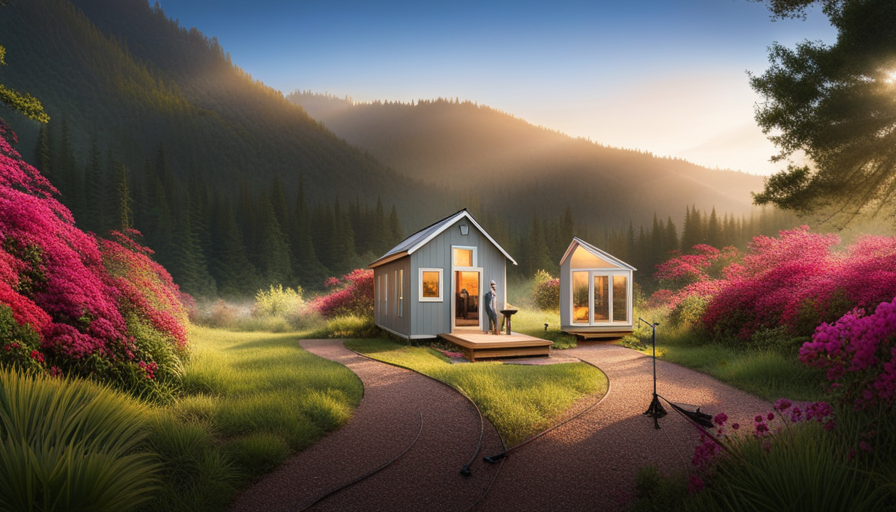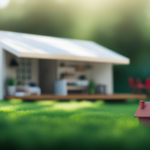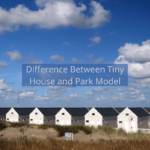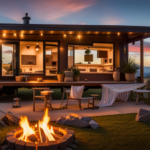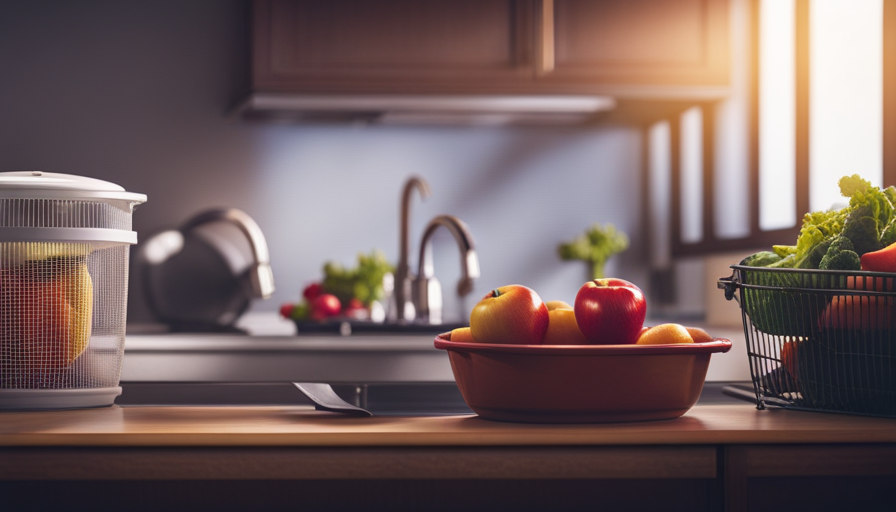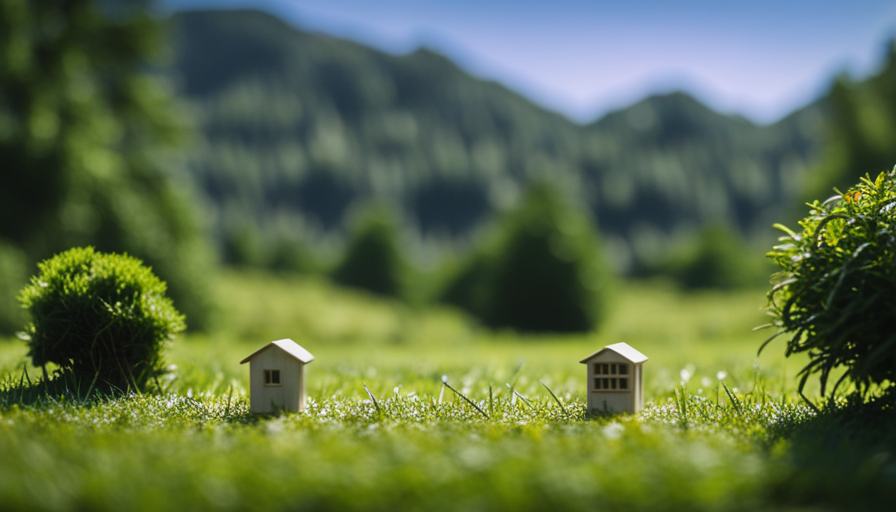You may be asking yourself – can a family truly live in a small house for a long time? It may seem like a temporary and far-fetched idea, correct? But get prepared to have your beliefs challenged. The average duration of living in a tiny home could easily defy your preconceived notions.
In this article, we will explore the factors that influence families to live in tiny houses and delve into the average length of their stay. We will examine the challenges and benefits of tiny house living, and provide tips on maximizing comfort and functionality in these compact spaces.
But let’s address the elephant in the room first – why would anyone choose to live in a tiny house, and for how long? Contrary to popular belief, many families are embracing the tiny house movement for the long haul. By prioritizing simplicity, minimalism, and financial freedom, families are finding that tiny houses offer a viable and sustainable living option.
So, let’s dive in and uncover the data-driven insights behind how long the average family lives in a tiny house.
Key Takeaways
- The average duration of residence in a tiny house is typically 4-6 years.
- Factors such as financial freedom, a minimalistic lifestyle, and a desire to live closer to nature influence the decision to live in a tiny house.
- Challenges of living in a tiny house include limited space, the need for decluttering and organization, and cost implications.
- Benefits of living in a tiny house include a simplified lifestyle, financial savings, and a reduced environmental impact.
Factors Influencing the Decision to Live in a Tiny House
The decision to live in a tiny house is often influenced by factors like financial freedom, minimalistic lifestyle, and a desire to live closer to nature, making it an attractive option for those seeking a simpler, more intimate way of living. However, it is important to consider the challenges faced and cost implications associated with this choice.
One of the main challenges faced by individuals living in tiny houses is the limited space. With a smaller living area, it becomes essential to declutter and prioritize belongings, which can be a significant adjustment for those accustomed to a more spacious living environment. Additionally, the lack of storage space may require creative solutions and careful organization to optimize the available area.
Another factor to consider is the cost implications of living in a tiny house. While the initial investment may be lower compared to traditional houses, there are ongoing expenses to consider, such as maintenance, utilities, and land rental. It is crucial to carefully budget and plan for these costs to ensure long-term sustainability.
The decision to live in a tiny house is influenced by various factors, including financial freedom, a minimalistic lifestyle, and a desire for a closer connection with nature. However, it is important to be aware of the challenges faced, such as limited space, and the cost implications associated with this choice. Understanding these factors will provide a more comprehensive perspective on the average duration of residence in tiny houses.
Average Duration of Residence in Tiny Houses
On average, you’ll typically stay in a tiny house for about 4-6 years. The average length of residence in a tiny house can vary depending on several factors, including individual lifestyle choices.
Some people choose to live in a tiny house as a temporary solution, while others see it as a long-term housing option. Factors such as job opportunities, family size, and personal circumstances can also influence the duration of residence in a tiny house.
There are several reasons why people may choose to live in a tiny house for a specific period. Some individuals may want to downsize and simplify their lives, while others may be seeking a more affordable housing option. Additionally, some people may view living in a tiny house as a way to minimize their environmental footprint or live a minimalist lifestyle. These lifestyle choices can play a significant role in determining how long a family stays in a tiny house.
As we explore the challenges and benefits of living in a tiny house, it becomes clear that the decision to reside in one is not without its considerations.
Challenges and Benefits of Living in a Tiny House
Living in a tiny house presents both challenges and benefits that should be carefully considered. Here are four key points to understand about the challenges and benefits of living in a tiny house:
-
Limited Space: One of the main challenges of living in a tiny house is the limited space available. It requires careful organization and creative storage solutions to make the most of the small living area.
-
Simplified Lifestyle: On the flip side, living in a tiny house encourages a simplified lifestyle. With fewer possessions and less space to clean and maintain, it can lead to a sense of freedom and reduced stress.
-
Financial Savings: One of the significant benefits of living in a tiny house is the potential for financial savings. Tiny houses are typically more affordable to purchase and maintain, resulting in lower utility bills and less overall spending.
-
Environmental Impact: Another benefit of tiny house living is its reduced environmental impact. The smaller size means less energy consumption and a smaller carbon footprint.
Considering these challenges and benefits, it’s important to weigh the pros and cons when deciding to live in a tiny house. Factors such as lifestyle preferences, financial considerations, and long-term plans will influence a family’s decision to move out of a tiny house.
Factors that Influence a Family’s Decision to Move Out of a Tiny House
Symbolically breaking free from the confines of a tiny house, families are often swayed to move out by a constellation of factors that shape their decision. Factors causing dissatisfaction in tiny house living can vary from family to family. Limited space, lack of privacy, and difficulty accommodating growing children are common concerns. Additionally, the lack of storage space and the challenge of maintaining a clutter-free environment can contribute to a family’s desire to move out.
Another significant factor that influences a family’s decision to leave a tiny house is changing family circumstances. As families grow and their needs change, the constraints of a tiny house may become more apparent. The arrival of a new baby, for example, can pose challenges in terms of space and privacy. Additionally, a job change or the need to relocate can make tiny house living impractical.
Various factors can lead a family to move out of a tiny house. Dissatisfaction with limited space, lack of privacy, and difficulty accommodating changing family circumstances are common reasons. However, there are ways to maximize comfort and functionality in a tiny house, which will be explored in the following section.
Tips for Maximizing Comfort and Functionality in a Tiny House
When it comes to maximizing comfort and functionality in a tiny house, two key points to consider are creative storage solutions and smart furniture design. These aspects play a crucial role in making the most out of limited space.
By utilizing innovative storage options and selecting furniture pieces that are multi-functional, individuals can optimize their living environment and create a more comfortable and efficient tiny house living experience.
Creative Storage Solutions
Maximizing space becomes a fun challenge in tiny houses with creative storage solutions. Smart storage solutions are essential for making the most of limited square footage.
Utilizing vertical space is key, with options like tall shelving units or floor-to-ceiling cabinets. Another space-saving technique is incorporating built-in storage into furniture pieces, such as hidden compartments in beds or benches.
Multi-purpose furniture is also popular in tiny houses, serving dual functions to maximize functionality. For example, a sofa can double as a guest bed or a dining table can transform into a desk. These innovative designs help to optimize space while still providing comfort and convenience.
Transitioning into the next section on smart furniture design, it is clear that both storage solutions and furniture design play crucial roles in creating a functional and comfortable living space in a tiny house.
Smart Furniture Design
Smart furniture design is a game-changer for creating a functional and comfortable living space in a tiny house. With limited square footage, every inch counts, and smart furniture design maximizes space utilization.
Here are two sub-lists that highlight the benefits of smart furniture design in small space organization:
-
Multifunctional furniture:
- Convertible sofas that turn into beds provide a sleeping area without sacrificing valuable floor space.
- Wall-mounted tables and foldable chairs can be easily tucked away when not in use, creating more room for movement.
-
Storage solutions:
- Built-in shelves and cabinets optimize vertical space, allowing for efficient organization of belongings.
- Hidden storage compartments in furniture pieces, such as ottomans or coffee tables, provide additional space for stowing items.
Efficient smart furniture design ensures that every item has a purpose and eliminates clutter, making tiny house living more comfortable.
Transitioning into the subsequent section about financial considerations for living in a tiny house, it’s essential to understand the cost-saving benefits of this lifestyle.
Financial Considerations for Living in a Tiny House
Living in a tiny house can be financially beneficial due to reduced expenses and a simplified lifestyle. Financial planning is crucial when considering this housing option, as it requires a different approach compared to traditional homes. The cost comparison between a tiny house and a conventional house is significant. Tiny houses are much more affordable, with lower purchase prices and reduced utility costs. Additionally, maintenance expenses are minimized, as the smaller space requires less cleaning and repairs. To illustrate the potential financial advantages, consider the following table:
| Expense | Tiny House | Conventional House |
|---|---|---|
| Purchase Price | $30,000 | $300,000 |
| Monthly Utilities | $100 | $300 |
| Maintenance | $50 | $200 |
These numbers clearly show the substantial savings that can be achieved by living in a tiny house. By embracing a minimalist lifestyle, individuals can allocate more funds towards other financial goals, such as saving for retirement or paying off debts. Furthermore, the simplified living in a tiny house allows for a more intentional use of resources, reducing waste and promoting sustainability. Transitioning into the subsequent section about the environmental benefits of tiny houses, it is important to consider the holistic advantages of this lifestyle choice.
Environmental Benefits of Tiny Houses
Embracing the tiny house movement allows us to make a powerful environmental impact by reducing our carbon footprint and living more sustainably.
Tiny houses are known for their sustainable living approach and minimalist lifestyle. By downsizing our living space, we consume less energy, produce less waste, and use fewer resources. The compact size of tiny houses requires less heating and cooling, resulting in lower energy consumption. Additionally, the use of eco-friendly materials in construction further promotes sustainable living.
Living in a tiny house encourages a minimalist lifestyle, where we prioritize experiences over possessions. This mindset helps reduce our consumption habits, leading to less waste generation. Moreover, tiny houses often incorporate environmentally friendly features such as composting toilets, rainwater collection systems, and solar panels, further reducing our ecological impact.
In addition to the environmental benefits, tiny houses promote a closer connection with nature. Many tiny house owners choose to live off-grid, relying on renewable energy sources and practicing sustainable gardening. This lifestyle encourages a deeper appreciation for the natural world and fosters a sense of responsibility towards preserving it.
Transitioning into the subsequent section about stories of families living long-term in tiny houses, we can see how sustainable living and a minimalist lifestyle can have a lasting impact on families who embrace the tiny house movement.
Stories of Families Living Long-Term in Tiny Houses
Imagine stepping inside a cozy, fairy tale-like dwelling where each corner holds cherished memories and every nook represents a family’s journey of togetherness and resilience. Stories of families living long-term in tiny houses are becoming increasingly common, showcasing the appeal and sustainability of this lifestyle.
These accounts provide a glimpse into the practicality and benefits of tiny house living. One such story is that of the Johnson family, who’ve been living in their tiny house for over five years. They initially downsized to minimize their ecological footprint and reduce expenses, but soon discovered the numerous advantages beyond environmental benefits. The close quarters encouraged stronger bonds between family members, fostering a sense of unity and cooperation. They found that living in a tiny house allowed them to focus on experiences rather than material possessions, leading to a more fulfilling and intentional lifestyle.
Another inspiring example is the Martinez family, who’ve been happily residing in their tiny house for over a decade. They chose this lifestyle to simplify their lives and prioritize their values. By eliminating excess space and possessions, they were able to focus on personal growth, financial freedom, and fostering meaningful connections with their community. Their story highlights the long-term viability of tiny house living and the positive impact it can have on individuals and families.
These stories of families living long-term in tiny houses demonstrate the potential for a fulfilling and sustainable lifestyle. In the subsequent section about community support and resources for tiny house living, we’ll explore how these families have found the necessary support and resources to thrive in their chosen lifestyle.
Community Support and Resources for Tiny House Living
When it comes to living in a tiny house, there are two key sources of community support and resources: online forums and communities, as well as workshops and events.
Online forums and communities provide a platform for tiny house enthusiasts to connect, share ideas, and seek advice from experienced individuals.
Workshops and events, on the other hand, offer hands-on learning experiences and opportunities to network with others in the tiny house community.
Both of these resources play a crucial role in supporting and empowering individuals who choose to live in tiny houses.
Online Forums and Communities
Online forums and communities are a great resource for tiny house enthusiasts to connect and share their experiences on how long the average family lives in a tiny house. These online networking platforms provide a virtual community where individuals can seek advice, exchange ideas, and find support.
Here are three key benefits of participating in these online forums:
-
Knowledge sharing: Members can learn from each other’s experiences, gaining insights into the challenges and joys of tiny house living. This exchange of information helps individuals make informed decisions about the longevity of their tiny house lifestyle.
-
Emotional support: Living in a tiny house can be a unique experience, and connecting with like-minded individuals can provide a sense of belonging and understanding. Online communities offer a space to share frustrations, celebrate successes, and find encouragement.
-
Resource recommendations: Members often share valuable resources such as maintenance tips, design ideas, and financial strategies. These recommendations can save time and money, contributing to a more sustainable and fulfilling tiny house journey.
By participating in online forums and communities, individuals can gather valuable information and support to make informed decisions about their tiny house lifestyle.
In the next section, we will explore the benefits of attending workshops and events to further enhance this knowledge.
Workshops and Events
To truly immerse yourself in the world of tiny houses, you can’t miss out on the opportunity to attend workshops and events where you can learn hands-on skills and connect with fellow enthusiasts.
Workshops offer a range of benefits, including the chance to gain practical knowledge on construction techniques, design principles, and sustainable living practices. These events are often organized by experts in the field who have years of experience in building and living in tiny houses.
They provide a platform for attendees to interact with like-minded individuals, share ideas, and find inspiration for their own tiny house projects. By participating in workshops and events, you can expand your knowledge, network with professionals, and gain valuable insights into the tiny house movement.
Looking ahead, let’s delve into the future trends and outlook for tiny house living.
Future Trends and Outlook for Tiny House Living
If you’re considering the future trends and outlook for tiny house living, it’s important to understand that the average family’s longevity in a tiny house is influenced by various factors such as location, lifestyle, and adaptability. Future trends suggest that more families will opt for tiny house living as a sustainable and affordable housing solution.
Sustainable living is becoming increasingly important as people seek to minimize their carbon footprint and live a more environmentally friendly lifestyle.
Here are five key aspects that highlight the future trends and outlook for tiny house living:
- Minimalistic lifestyle: Tiny houses encourage a simpler, clutter-free lifestyle, promoting a sense of freedom and reduced stress.
- Financial freedom: Living in a tiny house can lead to significant cost savings, allowing families to allocate their resources towards other priorities.
- Mobility: Tiny houses are often built on wheels, providing the flexibility to move and explore new locations easily.
- Community engagement: Tiny house communities are emerging, creating opportunities for social connections and support systems.
- Innovative design: The future of tiny house living involves advancements in design and technology, maximizing space utilization and energy efficiency.
By embracing these future trends and engaging in sustainable living practices, families can enjoy a fulfilling and environmentally conscious lifestyle in their tiny homes.
Frequently Asked Questions
Are there any legal challenges or restrictions when it comes to living in a tiny house?
There are legal implications and zoning regulations that can pose challenges to living in a tiny house. These restrictions vary depending on the location and local regulations.
Some areas may have minimum size requirements for dwellings, which tiny houses may not meet. Zoning laws may also restrict where tiny houses can be located, such as prohibiting them in certain residential areas.
It’s important to research and understand the specific legal requirements and restrictions in your area before considering living in a tiny house.
How does living in a tiny house affect children’s education and social development?
Living in a tiny house can have both positive and negative effects on children’s education and social development.
On the education front, it may require creative solutions for homeschooling or finding nearby schools. However, the close-knit environment can foster strong family bonds and encourage collaborative learning.
Socialization can be a challenge, but community activities and involvement can help mitigate this. Ultimately, the impact on education and socialization will depend on the specific circumstances and resources available.
Can you provide examples of creative storage solutions in a tiny house?
Creative storage solutions are essential in maximizing space in a tiny house. Some examples include built-in shelves and cabinets, under-bed storage, and multi-functional furniture like ottomans with hidden storage compartments.
Additionally, utilizing vertical space with hooks, racks, and hanging organizers can help keep items organized and easily accessible. These solutions allow families to efficiently store their belongings in a small space, making tiny house living more practical and comfortable.
Are there any specific maintenance or safety concerns unique to tiny house living?
Maintenance concerns and safety considerations are important aspects of tiny house living. Regular maintenance is necessary to ensure the longevity of the structure, including the roof, plumbing, and electrical systems.
Additionally, safety measures such as fire prevention and proper ventilation should be prioritized. It’s essential to have carbon monoxide and smoke detectors installed.
While living in a tiny house can be rewarding, addressing these maintenance concerns and safety considerations is crucial for a comfortable and secure living environment.
What are some alternative options for families who want to downsize but aren’t ready for a tiny house lifestyle?
There are several alternative housing options for families who want to downsize but aren’t ready for a tiny house lifestyle.
One option is to consider smaller apartments or condominiums, which still offer the benefits of downsizing while providing a more traditional living space.
Another option is to explore modular or prefabricated homes, which offer customizable and efficient living spaces.
Additionally, some families may choose to rent or purchase smaller single-family homes or townhouses as a way to downsize without fully committing to the tiny house movement.
Conclusion
In conclusion, the average family’s duration of residence in a tiny house is influenced by various factors, including financial considerations, lifestyle choices, and the ability to maximize comfort and functionality.
While there are challenges associated with living in a small space, many families have found long-term success in tiny house living, benefiting from reduced environmental impact and community support.
As the tiny house movement continues to gain momentum, it’s expected that more families will embrace this alternative lifestyle, creating a sustainable and thriving future.
Like a seed planted in fertile soil, the tiny house movement will continue to grow and flourish.
Hi, I’m Emma. I’m the Editor in Chief of Tiny House 43, a blog all about tiny houses. While tree houses are often associated with childhood, they can be the perfect adult retreat. They offer a cozy space to relax and unwind, surrounded by nature. And since they’re typically built on stilts or raised platforms, they offer stunning views that traditional homes simply can’t match. If you’re looking for a unique and romantic getaway, a tree house tiny house might just be the perfect option.

